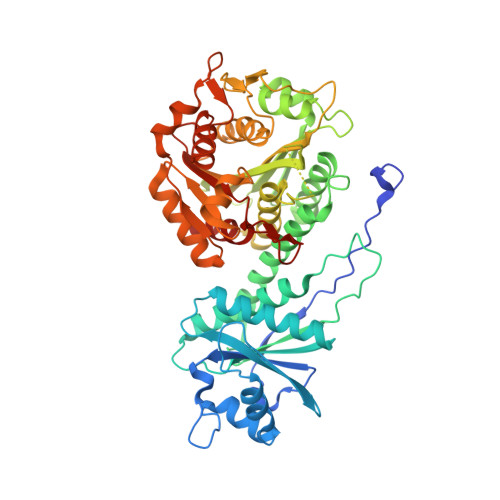Structural insights into chaperone-activity enhancement by a K354E mutation in tomato acidic leucine aminopeptidase.
DuPrez, K.T., Scranton, M.A., Walling, L.L., Fan, L.(2016) Acta Crystallogr D Struct Biol 72: 694-702
- PubMed: 27139632
- DOI: https://doi.org/10.1107/S205979831600509X
- Primary Citation of Related Structures:
5D8N - PubMed Abstract:
Tomato plants express acidic leucine aminopeptidase (LAP-A) in response to various environmental stressors. LAP-A not only functions as a peptidase for diverse peptide substrates, but also displays chaperone activity. A K354E mutation has been shown to abolish the peptidase activity but to enhance the chaperone activity of LAP-A. To better understand this moonlighting function of LAP-A, the crystal structure of the K354E mutant was determined at 2.15 Å resolution. The structure reveals that the K354E mutation destabilizes an active-site loop and causes significant rearrangement of active-site residues, leading to loss of the catalytic metal-ion coordination required for the peptidase activity. Although the mutant was crystallized in the same hexameric form as wild-type LAP-A, gel-filtration chromatography revealed an apparent shift from the hexamer to lower-order oligomers for the K354E mutant, showing a mixture of monomers to trimers in solution. In addition, surface-probing assays indicated that the K354E mutant has more accessible hydrophobic areas than wild-type LAP-A. Consistently, computational thermodynamic estimations of the interfaces between LAP-A monomers suggest that increased exposure of hydrophobic surfaces occurs upon hexamer breakdown. These results suggest that the K354E mutation disrupts the active-site loop, which also contributes to the hexameric assembly, and destabilizes the hexamers, resulting in much greater hydrophobic areas accessible for efficient chaperone activity than in the wild-type LAP-A.
Organizational Affiliation:
Department of Biochemistry, University of California Riverside, Riverside, CA 92521, USA.


















